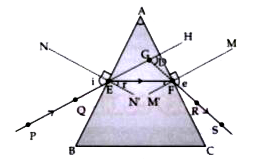Explain the refraction of light through a triangular glass prism using a labelled ray diagram. Hence define the angle of deviation.
The light ray PE enters from air to glass (rarer to denser medium) at surface AB and therefore, bends towards the normal. The refracted ray EF now exits from glass and enters air (from denser to rarer medium) and therefore, bends away from the normal Extra-potation of incident and emergent ray gives the angle of deviation

(i) ABC is prism with base BC.
(ii) PE is incident ray on surface AB. It makes ∠PEN with the normal NE. This angle is angle of incidence.
(iii) After entering the prism the light ray bends towards normal. In this case, EF is refracted ray. ∠N.EF is angle of refraction
(iv) Once the retracted ray emerges from prism into air, it bends away from normal. In this figure, FS is emergent ray. ∠SFM is angle of emergence.
Angle of deviation : The angle between incident may and emergent ray is called angle of deviation. Here, ∠SGH is angle of deviation or ∠D.
Similar Questions
Explain the refraction of light through a triangular glass prism using a labelled ray diagram. Hence define the angle of diviation.
View SolutionExplain the refraction of light through a triangular glass prism using a labelled ray diagram. Hence define the angle of diviation.
View SolutionWhat is a prism ? Draw a neat diagram to show refraction of a light ray through a triangular glass prism. Define angle of deviation.
View SolutionExplain the phenomenon of dispersion of white light through a glass prism, using suitable ray diagram.
View SolutionExplain the phenomenon of dispersion of white light through a glass prism, using suitable ray diagram.
View SolutionExplain the phenomenon of dispersion of white light through a glass prism, using suitable ray diagram.
View SolutionDefine refractive index of a transparent medium. A ray of light passes through a triangular prism. Plot a graph showing the variation of the angle of deviation with the angle of incidence.
View SolutionDefine refractive index of a transparent medium. A ray of light passes through a triangular prism. Plot a graph showing the variation of angle of deviation with the angle of incidence. Hence derive prism formula.
View SolutionDefine refractive index of a transparent medium. A ray of light passes through a triangular prism. Plot a graph showing the variation of angle of deviation with the angle of incidence.
View Solution(a) Draw a ray diagram showing the passage of light through a glass prism. Hence obtain a relation between the angles of deviation, incidence and emergence and angle of prism.
(b) Show that no ray can pass through a prism whose refracting angle A is greater than twice the critical angle for the material of the prism.
View Solution
